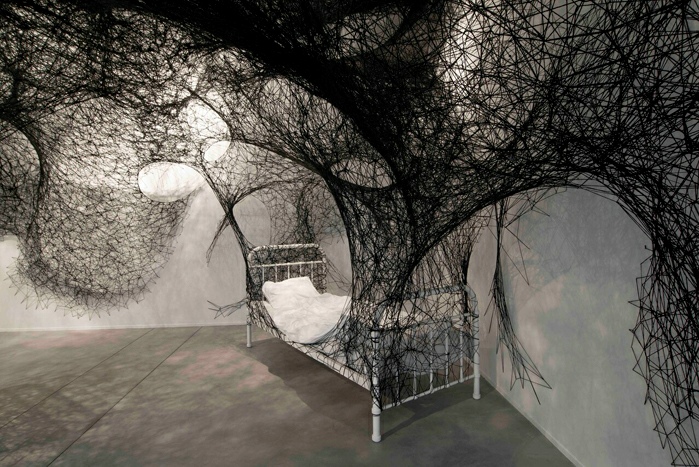Press Release
Red Brick Art Museum will present Silent Emptiness on March 23,a major solo exhibition by artist Chiharu Shiota. Curated by Yan Shijie, the exhibition features a series of newly created site-

International ongoing exhibitions
Chiharu Shiota, Silent Emptiness
Red Brick Art Museum, Beijing (China)
23.03 - 31.08.2025
International Archives 2nd half of 2024International Archives 1st half of 2024
International Archives 2ndt half of 2023International Archives 1st half of 2023
International Archives 2nd half of 2022International Archives 1st half of 2022
International Archives 2nd half of 2021International Archives 1st half of 2021
International Archives 2nd half of 2020International Archives 1st half of 2020
International Archives 2nd half of 2019International Archives 1st half of 2019
International Archives 2nd half of 2018International Archives 1rst half of 2018
Legal Notice

Silent Emptiness also showcases Chiharu Shiota’s manuscripts specially made for this exhibition, as well as archival photographs and video documentation tracing her artistic practice and journey:how she, as a Japanese artist, step by step entered the global contemporary art scene from Berlin, transitioning from paintings to immersive large-
Reconstructing the poetics of “emptiness” between East and West
Shiota emphasizes the unique architectural style of Red Brick Art Museum: “Its space, which blends the meditative tranquility of Eastern gardens with the structural order of Western architecture, has an ineffable connection to my cultural background.” Curator Yan Shijie responds, “Each of Shiota’s works fully integrates with the architecture and space of Red Brick, transforming into a profound spatial field,constructing an ultimate inquiry into ‘existence’,leading toward the enlightenment of ‘emptiness’ in Eastern philosophy.”
Gateway to Silence centers around an ancient large-
Chiharu Shiota draws inspiration from Zhuangzi’s butterfly dream for Metamorphosis of Consciousness. Through suspended butterfly wings and beds imbued with residual body warmth, she challenges the duality of “body and consciousness.” The artist candidly states, “While each time we slip into sleep, it is a rehearsal for death—a journey beyond the body.” Here, “emptiness” dissolves the boundaries of life and death.
In Echoes of Time, three uncrafted rocks give “time” a tangible form. The wave-
In Rooted Memory, a decommissioned wooden boat from Zhuozhuang Reservoir in Xingtai, Hebei, occupies the central space. From the cracks in its hull, a tree emerges, with red ropes cascading like raindrops, nourishing its roots. Through the imagery of a tree growing from a boat, Chiharu Shiota constructs a symbiotic cycle between nature and human creation: The tree is the origin of the wooden boat. Now, the boat has given rise to a tree, as if returning to its source. The dissolution of matter as the very beginning of life’s cycle.
“Salt crystallization”: self-
As an artist living in Berlin for a long time, Shiota’s work navigates the interplay between her “Eastern heritage” and “global experiences.” She once described the flow and condensation of her transnational identity through the metaphor of salt crystallization: “In Germany, I feel I learned to see more parts of me that were invisible in Japan. When you leave salt water on a dish, for example, water evaporates and only salt remains. The salt which you could not see in the salt water crystallizes. I was not visible as an individual in Japan. Whereas I did not know who I was, what I wanted to do, and what was necessary in the water, I feel that I became an individual and crystal, and understood those things for the first time by coming to Germany.” [1]
This “awakening in displacement ” permeates her art. The installation Multiple Realities features empty dresses, symbolizing both a “second skin” and an inquiry into “the dance of the soul after the body gone.” Shiota explains: “Clothing carries memories, emotions, and experiences—it is an extension of the self.” Clothes carry the weight of our memories, emotions, and experiences, becoming an extension of ourselves.” As the large dresses slowly spin in the dark room, their reflections shown in calm water. The movements of the dresses feel like a dance of absence, where the body is gone, but its presence is still felt in the fabric’s motion, echoing Shiota’s concept of “the presence in absence “—”Absence does not signify disappearance but rather an integration into a vaster universe, re-
The exhibition also includes early performance videos such as Bathroom (1999) and Wall (2010), where Shiota explores transnational identity and displacement through her body. In Bathroom, the act of cleansing exposes memory’s stubbornness, akin to an indelible imprint on the skin—both a witness to personal history and an inseparable part of identity. In Wall, the body is both “the wall” and “the imprisoned,” with blood vessel-
From performance to installation, Shiota extensively employs “fiber,” “dirt”, and “second-
Entering Red Brick Art Museum, visitors embark on a journey to “perceive emptiness.” As matter fades, bodies perish, and time flows, how do we anchor ourselves through memory, art, and faith? Shiota’s answer resides in the trembling of every thread: rupture and connection are one; new life sprouts from ruins.
Silent Emptiness is not just an exhibition—it is a philosophical manifesto. Using fiber as warp and ordinary objects as weft, Shiota weaves a contemporary interpretation of “emptiness”—it is not void but the freedom of all things arising through interdependence; not nihilism but a compassionate confrontation with life and death.
Emptiness, such as it is, does not obstruct the flourishing of all things.
[1] Chiharu Shiota, interview with Aomi Okabe, transcribed and edited by Mayuko Aota, Musashino Art University, Department of Arts Policy and Management, 2009.
Chiharu Shiota, Sleeping is like death, 2016. Photo: Isabelle Arthuis. © VG Bild-

Exhibition 23 March -

© ArtCatalyse International / Marika Prévosto 2025 All Rights Reserved